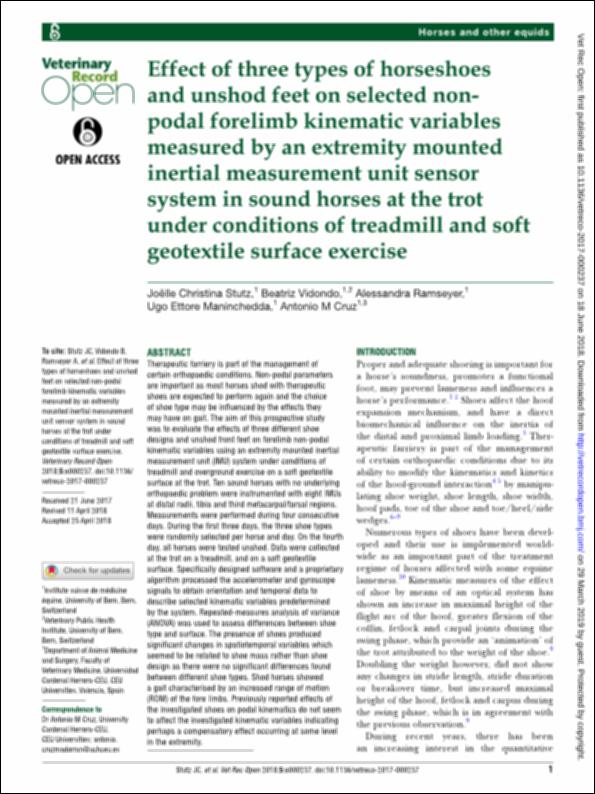Please use this identifier to cite or link to this item:
http://hdl.handle.net/10637/10475Effect of three types of horseshoes and unshod feet on selected nonpodal forelimb kinematic variables measured by an extremity mounted inertial measurement unit sensor system in sound horses at the trot under conditions of treadmill and soft geotextile surface exercise
| Title: | Effect of three types of horseshoes and unshod feet on selected nonpodal forelimb kinematic variables measured by an extremity mounted inertial measurement unit sensor system in sound horses at the trot under conditions of treadmill and soft geotextile surface exercise |
| Authors : | Stutz, Joëlle Christina Vidondo Currás, Beatriz Ramseyer, Alessandra Maninchedda, Ugo Ettore Cruz Madorrán, Antonio |
| Keywords: | Caballos - Sistema musculoesquelético - Heridas y lesiones - Tratamiento.; Horses - Musculoskeletal system - Wounds and injuries - Treatment.; Lameness in horses - Treatment.; Animal mechanics.; Cojera en los caballos - Tratamiento.; Mecánica animal. |
| Publisher: | British Veterinary Association. |
| Citation: | Stutz, JC., Vidondo, B., Ramseyer, A., Maninchedda,UE & Madorrán Cruz, A. (2018). Effect of three types of horseshoes and unshod feet on selected nonpodal forelimb kinematic variables measured by an extremity mounted inertial measurement unit sensor system in sound horses at the trot under conditions of treadmill and soft geotextile surface exercise. Veterinary Record Open, vol. 5, n. 1, art. e000237. DOI: http://dx.doi.org/10.1136/vetreco-2017-000237 |
| Abstract: | Therapeutic farriery is part of the management of certain orthopaedic conditions. Non-podal parameters are important as most horses shod with therapeutic shoes are expected to perform again and the choice of shoe type may be influenced by the effects they may have on gait. The aim of this prospective study was to evaluate the effects of three different shoe designs and unshod front feet on forelimb non-podal kinematic variables using an extremity mounted inertial measurement unit (IMU) system under conditions of treadmill and overground exercise on a soft geotextile surface at the trot. Ten sound horses with no underlying orthopaedic problem were instrumented with eight IMUs at distal radii, tibia and third metacarpal/tarsal regions. Measurements were performed during four consecutive days. During the first three days, the three shoe types were randomly selected per horse and day. On the fourth day, all horses were tested unshod. Data were collected at the trot on a treadmill, and on a soft geotextile surface. Specifically designed software and a proprietary algorithm processed the accelerometer and gyroscope signals to obtain orientation and temporal data to describe selected kinematic variables predetermined by the system. Repeated-measures analysis of variance (ANOVA) was used to assess differences between shoe type and surface. The presence of shoes produced significant changes in spatiotemporal variables which seemed to be related to shoe mass rather than shoe design as there were no significant differences found between different shoe types. Shod horses showed a gait characterised by an increased range of motion (ROM) of the fore limbs. Previously reported effects of the investigated shoes on podal kinematics do not seem to affect the investigated kinematic variables indicating perhaps a compensatory effect occurring at some level in the extremity. |
| Description: | Este artículo se encuentra disponible en la siguiente URL: https://vetrecordopen.bmj.com/content/vetreco/5/1/e000237.full.pdf |
| URI: | http://hdl.handle.net/10637/10475 |
| Rights : | http://creativecommons.org/licenses/by-nc/4.0/deed.es |
| ISSN: | 2052-6113 (Electrónico). |
| Issue Date: | 18-Jun-2018 |
| Center : | Universidad Cardenal Herrera-CEU |
| Appears in Collections: | Dpto. Medicina y Cirugía Animal |
Items in DSpace are protected by copyright, with all rights reserved, unless otherwise indicated.


